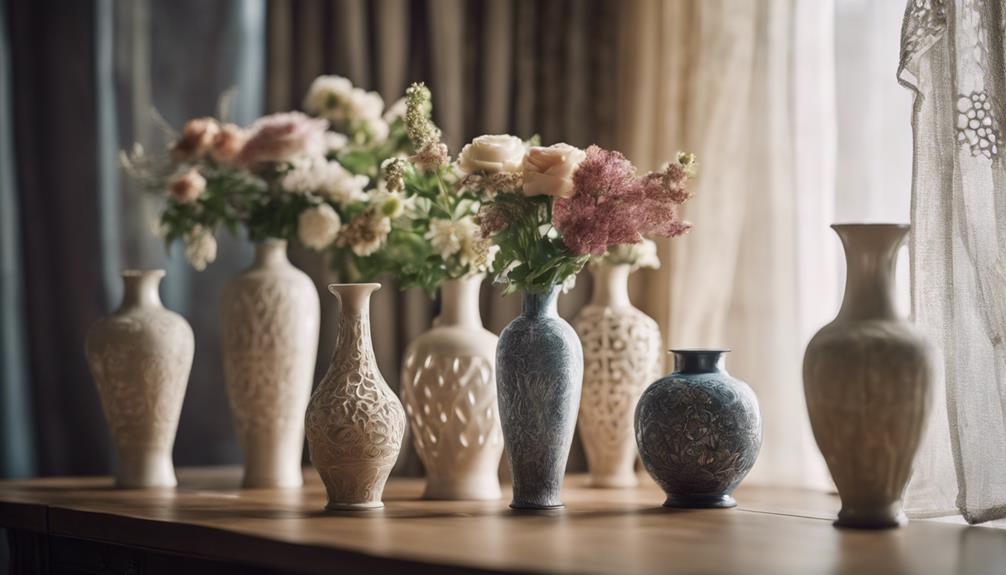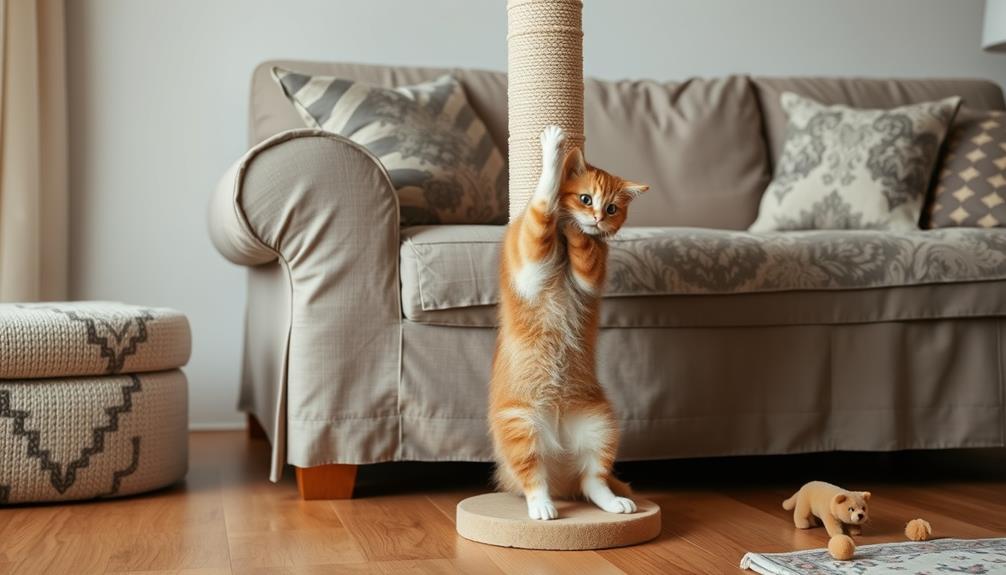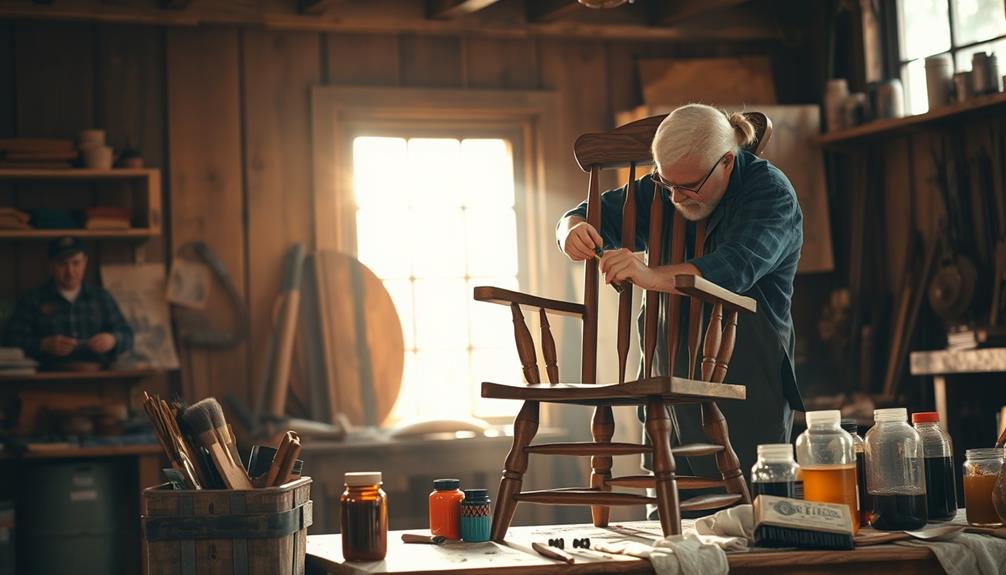You can easily restore wood furniture using vinegar. Start by mixing equal parts of white vinegar and water in a spray bottle. Clean the surface with a damp cloth using this solution, rubbing along the grain to avoid scratches. For added shine, mix in olive oil. Once cleaned, buff the furniture with a dry cloth to enhance its luster. If you encounter sticky residues, soften them with the vinegar solution and a plastic scraper. Regular maintenance with this mixture can keep your wood looking great. Discover more tips for great results that'll make your furniture shine like new.
Key Takeaways
- Clean the wood surface with a mixture of equal parts water and vinegar, using a damp cloth to avoid saturation.
- For tough stains, apply a stronger vinegar solution or soak a cloth in vinegar and lay it on the stain.
- Buff the wood with a clean, dry cloth after applying the vinegar solution to enhance shine and remove excess moisture.
- Mix vinegar with olive oil for polishing, which nourishes the wood and helps prevent cracking over time.
- Regularly maintain restored furniture by cleaning and polishing monthly with a vinegar and oil solution for lasting beauty.
Preparing Wood Surfaces

Preparing wood surfaces is essential for achieving a beautiful finish on your furniture. Start by giving the surface a gentle cleaning. Mix a little dishwashing soap with warm water to create a solution that effectively removes dirt without damaging the wood. For tougher grime, you can use a vinegar and water mixture, but make sure to test it on a hidden area first. Apply your chosen cleaning solution with a soft microfiber cloth or sponge, gently scrubbing the surface. Once you've removed the dirt, wipe away any soap residue with a clean cloth dampened in plain water and dry the surface thoroughly to prevent watermarks. It's important to remember that restoring wood furniture is often more economical than buying new, high-quality pieces.
Next, you need to strip any old finish. This step is crucial to reveal the wood's actual condition. Use a gel-based paint stripper or oven cleaner, allowing it ample time to work. After that, use steel wool to help remove the old finish completely.
Finally, sand the surface to ensure a smooth result. Start with lower-grit sandpaper, then progress to higher-grit for a refined finish. Remember to dust the wood thoroughly afterward, ensuring it's clean and ready for the next steps.
Mixing the Vinegar Solution
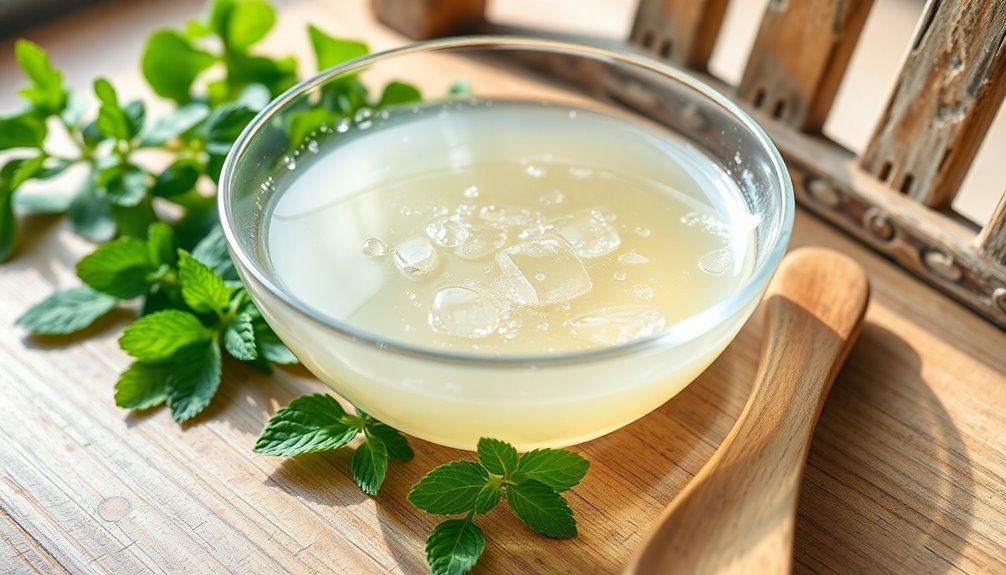
Mixing a vinegar solution is a simple yet effective way to clean and polish your wood furniture. Start by mixing equal parts of water and white vinegar for a safe cleaning solution. For a stronger option, use 3 tablespoons of white vinegar with 1 cup of filtered water. Always dilute vinegar with water; undiluted vinegar can damage the wood. Before applying it to the entire piece, test your solution on a small, inconspicuous area. Once you have confirmed that the solution is safe for your furniture, you can proceed to apply it using a soft cloth. Gently wipe the surface, going with the grain of the wood to avoid scratches. For those looking for a comprehensive guide, there are many resources available that explain how to use vinegar for cleaning various surfaces effectively. Always remember to follow up with a dry cloth to prevent any moisture from lingering on the wood.
For polishing, combine equal parts of white vinegar and olive oil. If you want a pleasant aroma, add a small squirt of fresh lemon juice. You can also adjust the ratio to ¾ olive oil and ¼ vinegar if you're concerned about the vinegar smell. Just remember to test this mixture as well. Using a mixture of olive oil and vinegar not only cleans but also conditions the wood, enhancing its overall appearance.
Always use white vinegar for its gentle but effective properties. Olive oil conditions the wood, enhancing its color. Avoid harsh chemical cleaners that strip natural oils from the wood. Keep your cloth damp, not dripping, to prevent excess moisture. Finally, work in a well-ventilated area to minimize strong smells during the mixing process.
Applying the Vinegar Solution
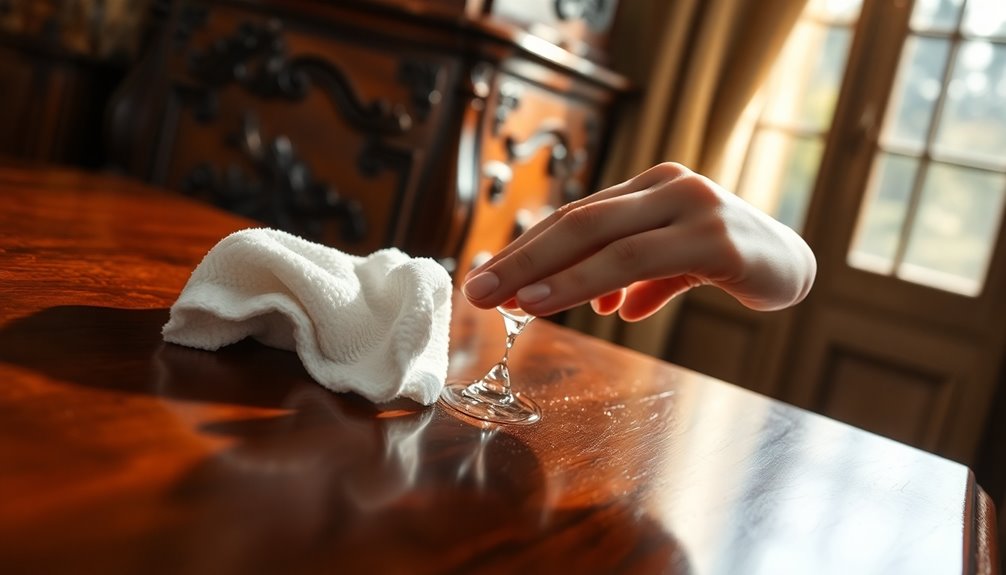
How can you effectively apply the vinegar solution to restore your wood furniture? Start by dampening a soft, clean cloth with the vinegar solution. Make sure the cloth isn't too wet—just moist enough to work with. Never apply the solution directly onto the furniture, as this can lead to excessive moisture. Instead, use circular motions to gently rub the solution into the wood, always following the grain. If you encounter stubborn spots, apply a little extra pressure or add more solution to your cloth.
Be cautious not to saturate the wood, as too much moisture can warp or damage it. For sticky residues, consider using rubbing alcohol or vodka on a separate cloth instead of vinegar. If your furniture has a finish that might be affected, use a diluted vinegar solution and test it on an inconspicuous area first. When applying, ensure that you distribute the solution evenly across the surface, maintaining a consistent appearance. This process not only enhances the wood's appearance but also acts as a natural disinfectant, ensuring cleanliness as you restore its beauty. Remember to treat all parts of the furniture uniformly for the best results. This careful application will help restore the beauty of your wood furniture effectively.
Buffing and Drying
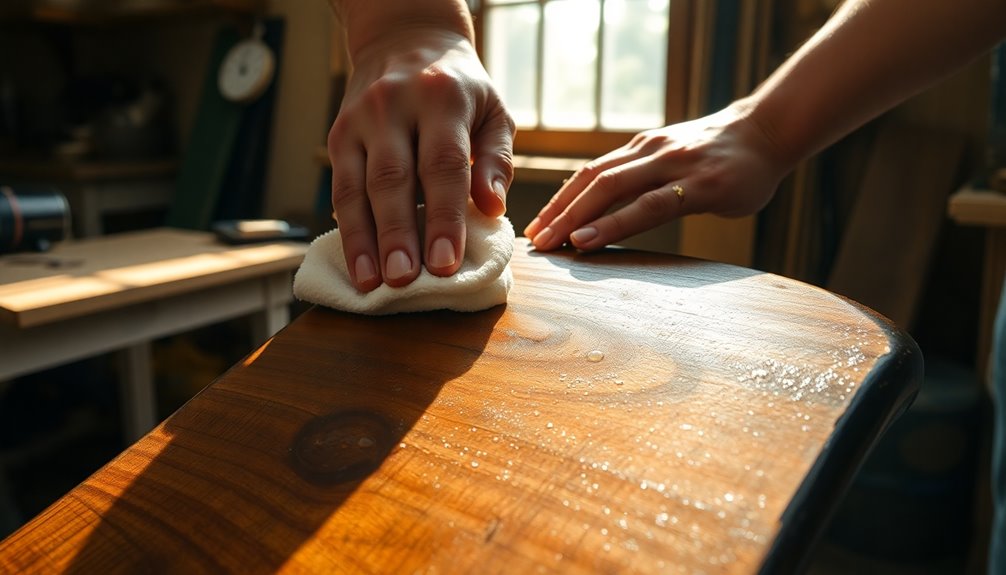
Once you've applied the vinegar solution, it's time to buff and dry the wood surface to enhance its shine and protect it. Grab a clean, dry cloth and start buffing the surface in circular motions. This technique helps spread the oil evenly and prevents any spots from becoming overly saturated. Make sure the cloth is completely dry; you don't want to add more moisture to the wood. Buffing is crucial for removing excess solution, which can prevent damage to the wood and enhance its shine. Additionally, regular cleaning contributes to a healthier living environment by reducing allergens.
After buffing, allow the polished area to dry for several hours. It's essential to avoid using the furniture until it's fully dry to prevent any damage or staining. Keep in mind that drying time may vary depending on the wood's thickness and the ambient humidity. To speed up the drying process, ensure good ventilation in the room. Once dry, you'll notice the wood looks newer and brighter. Remember to regularly include this buffing and drying process in your maintenance routine to keep your wood furniture looking its best!
Handling Sticky Residue
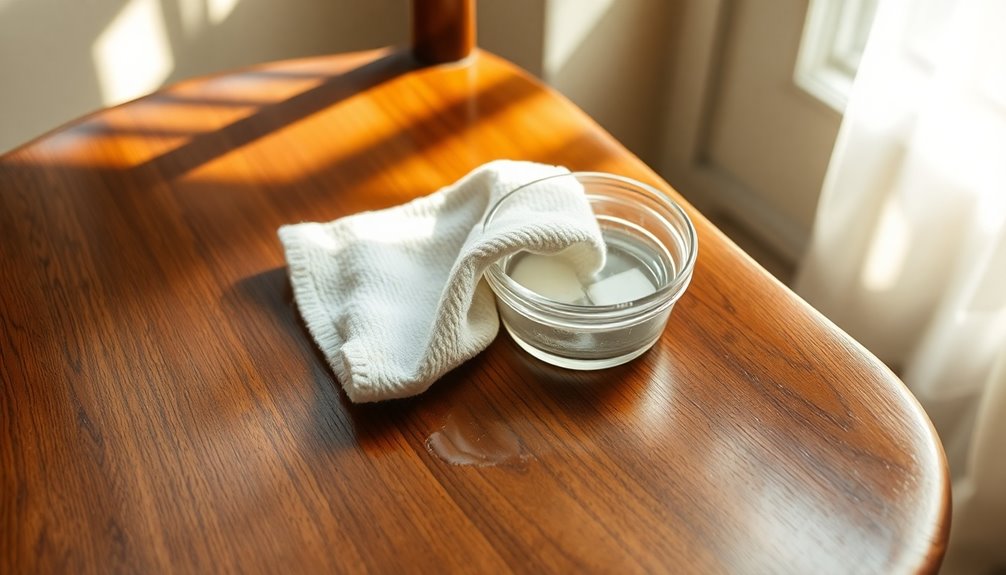
When dealing with sticky residue on your wood furniture, the first step is to prepare an effective cleaning solution. Mix equal parts of white vinegar and water for a gentle cleaner, or combine one part vinegar with one or two parts olive oil to clean and condition the wood simultaneously. Just be cautious not to make the solution too concentrated, as it could damage the wood finish. Always test it on a small, inconspicuous area first.
Next, use a hair dryer to soften the sticky residue, which makes it easier to remove. Gently scrape off the softened residue with a plastic scraper or an old credit card, applying minimal pressure to avoid scratching the wood. Dampen a soft, lint-free cloth with your vinegar solution and rub it into the sticky area, following the grain of the wood. For stubborn residue, consider using rubbing alcohol or vodka on a cloth for gentle scrubbing. Remember to avoid excessive moisture as it can harm the wood. By following these steps, you'll effectively handle sticky residue and keep your furniture looking great. Additionally, regular cleaning can help prevent the buildup of sticky residues caused by spills and food particles over time.
Removing Stains Effectively

Stains on wood furniture can be frustrating, but with the right techniques, you can restore its beauty. Start by tackling general stains using white vinegar. Soak a cloth in white vinegar, wring it out, and rub the stained area until the stain lifts. If that doesn't work, mix two parts vinegar with one part water and apply it with a soft cloth. For tougher stains, combine equal parts vinegar and olive oil, saturate the stain, and let it sit for an hour before wiping it off.
For ink stains, use vinegar and a toothbrush. Apply vinegar to the stain, let it sit for at least 30 minutes, then wipe it away with a wet cloth. If any ink remains, dab rubbing alcohol on it using a cotton ball until it's gone. It's essential to test each method on an inconspicuous area before full application to avoid any damage.
To remove drink or water stains, apply toothpaste with a damp cloth or mix equal parts vinegar and water, letting it sit for about 30 minutes. For greasy stains, mix ammonia with cold water, or use a paste of baking soda and water.
Always buff the area dry with a clean cloth after treatment, and repeat as necessary until the stain is completely gone.
Maintenance Tips
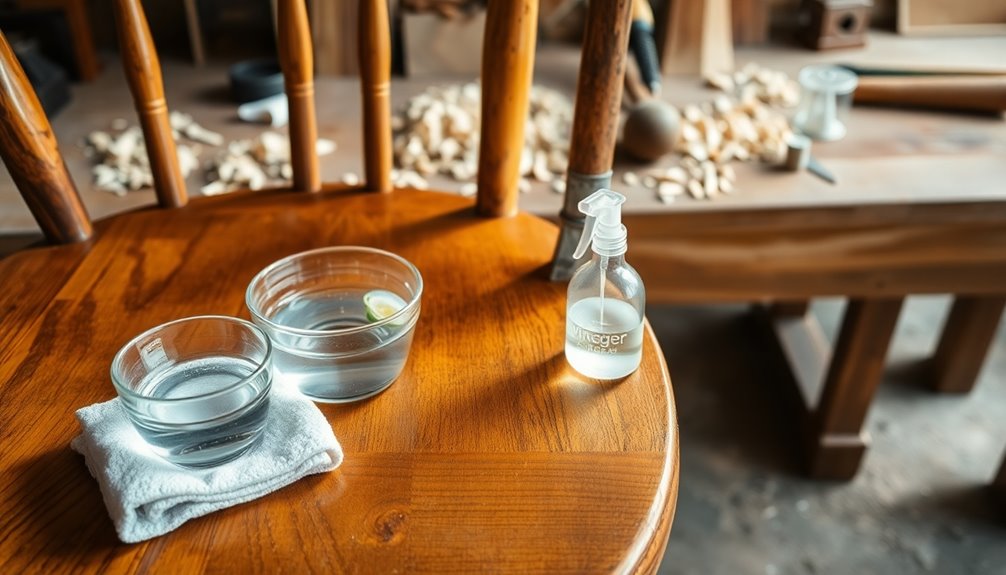
Regular maintenance is essential for keeping your wood furniture looking its best. Start by dusting regularly with a dusting brush or a slightly dampened cloth to remove dust and grime. Aim to clean and polish your wood furniture once a month using a vinegar and oil solution. Remember to avoid harsh chemicals; natural solutions like vinegar and oil are safer for your furniture.
When applying cleaning solutions, always rub with the grain to prevent scratches and enhance absorption. Ensure your cloth is damp, not wet, to avoid saturating the wood and causing warping. Use soft, lint-free cloths to protect the surface. Additionally, using diluted vinegar is crucial as it prevents damage to the wood's natural oils.
After cleaning, buff the wood with a dry cloth in a circular motion to eliminate excess moisture and boost shine. For an added touch, mix equal parts of white vinegar and olive oil for polishing, and consider adding a few drops of essential oil for a pleasant aroma. Lastly, allow the polished area to dry for several hours to ensure full absorption. By following these maintenance tips, you'll keep your wood furniture looking beautiful and extend its lifespan.
Benefits of Vinegar
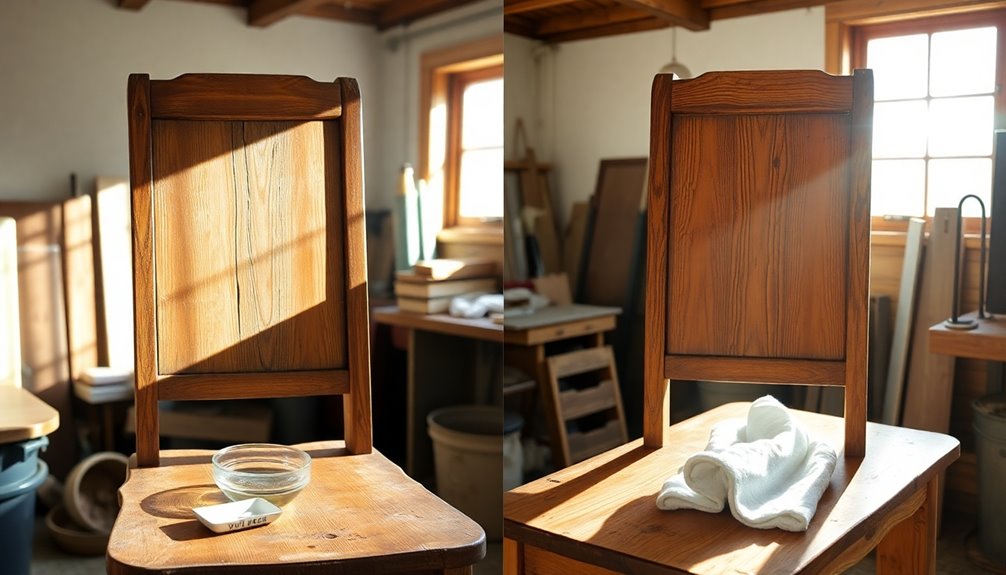
Vinegar offers numerous benefits for restoring and maintaining wood furniture, making it an invaluable addition to your cleaning routine. Its acetic acid content effectively cuts through dirt and grime, dissolving stubborn buildup on wood surfaces. As a mild acid, vinegar penetrates deep, ensuring a thorough clean while also removing remnants of previous cleaning products. Additionally, vinegar's acidic nature helps break down grease that may accumulate on wood surfaces, enhancing the overall cleaning process. Regular maintenance with vinegar can help prevent long-term issues such as cracking or fading of the wood.
Not only does vinegar clean, but it also disinfects. It kills bacteria and other microorganisms, helping you maintain a hygienic environment around your wood furniture. This contributes to the overall health and longevity of the wood, proving that vinegar is a safe and natural alternative to harsh chemicals.
When mixed with olive oil, vinegar becomes even more beneficial. This combination nourishes the wood, enriching its color and texture while protecting it from damage. It prevents the wood from drying out and losing its natural oils, maintaining its beauty and luster.
Just remember to dilute vinegar with water to avoid damaging the wood. This versatile and cost-effective solution works on various wood finishes, making it an excellent choice for all your cleaning needs.
Alternative Cleaning Solutions

What if you could clean and restore your wood furniture using simple, natural ingredients? You don't have to rely solely on vinegar-based solutions; there are several effective alternatives. One option is mixing olive oil with lemon juice. This combination not only polishes your wood but also leaves a refreshing scent. It acts as a natural sealant, moisturizing the wood while enhancing its beauty. Additionally, these homemade options reduce reliance on commercial products, making them a sustainable choice for wood care and echoing the principles of eco-friendly materials in children's toys.
Another great choice is a beeswax and oil blend. Combine beeswax with olive or coconut oil for a nourishing polish that protects the surface. This solution works well on both finished and unfinished wood, creating a glossy, durable finish.
If you're tackling scuffs and marks, try mixing baking soda with water to form a paste. Applying this gently with a damp sponge helps lift blemishes without harming your wood's finish. It's a safe, cost-effective solution you likely already have at home.
Lastly, consider a black tea solution. Steeping tea bags in boiling water and then applying the cooled mixture with a microfiber mop can brighten your wood's shine and bring out its warm tones. These natural alternatives can effectively restore your furniture while keeping it safe and beautiful.
Safety Precautions
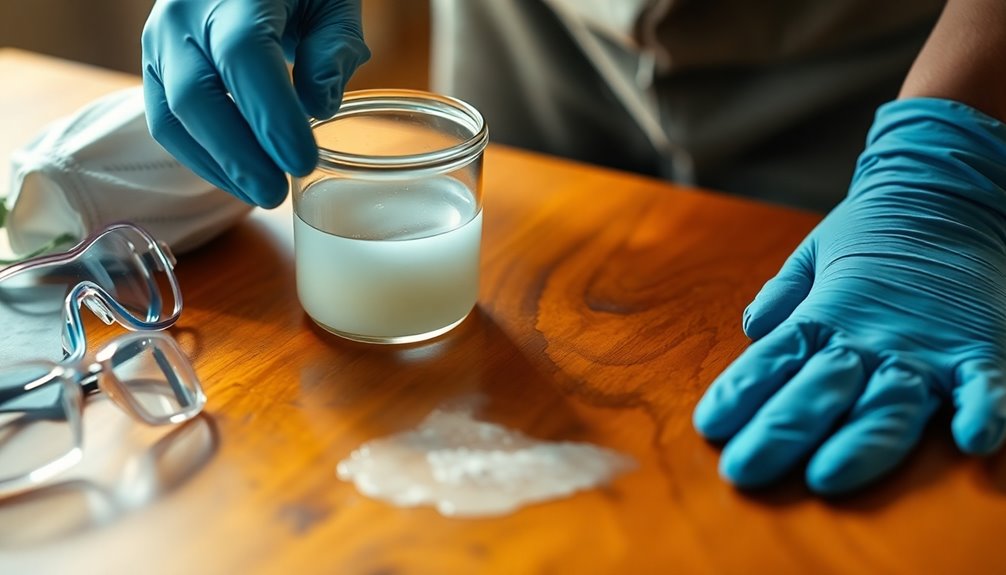
Cleaning and restoring your wood furniture can be rewarding, but it's important to take safety precautions to protect both the wood and yourself. Start by removing dust and debris with a dry microfiber cloth to avoid scratches. Vacuum or dust thoroughly, clearing the furniture of any items that might interfere with your cleaning process.
Before applying any vinegar solution, test it on a hidden area first. This helps you check for discoloration or damage; wait a few minutes to see if there are any adverse effects. Avoid using undiluted vinegar, as it can harm finishes. Always dilute vinegar with water—half a cup of white vinegar to a gallon of warm water is a safe ratio. Continuous exposure to vinegar can lead to wood structure degradation, which is why proper dilution and care are essential.
Be cautious with continuous exposure to vinegar, as it can corrode wood surfaces over time. Don't apply vinegar to waxed, oiled, or unfinished wood. When cleaning, use a soft, slightly damp cloth, and buff out excess moisture to prevent warping. Lastly, allow the area to dry completely before using the furniture again to ensure it stays in great condition.
Frequently Asked Questions
Can I Use Vinegar on All Types of Wood Finishes?
You can't use vinegar on all types of wood finishes without caution. While diluted white vinegar is generally safe for most finishes, undiluted vinegar can harm them. Always test the solution in an inconspicuous spot first to check for any damage or discoloration. Avoid using vinegar on unsealed or raw wood, and be mindful that some finishes, like laminate or certain antiques, may require professional cleaning methods instead.
How Often Should I Restore My Wood Furniture?
You should restore your wood furniture every 10 to 20 years, depending on how much it's used. Regular maintenance, like dusting weekly and cleaning high-traffic areas, keeps it looking good. Apply wood wax or oil every few months to nourish the wood. Always inspect for wear or damage, and don't hesitate to fix minor scratches promptly to prevent further issues. Keeping it protected from the environment also prolongs its lifespan.
Will Vinegar Damage Antique Wood Furniture?
Vinegar can potentially damage antique wood furniture if it's used undiluted. The acidity may strip the natural oils and finish, leading to dullness or dryness. To avoid this, always dilute vinegar with water before applying it. Test the solution on an inconspicuous area first to ensure it won't harm the wood. By taking these precautions, you can clean your antique pieces safely without risking damage to their finish or integrity.
Can I Mix Essential Oils With the Vinegar Solution?
Yes, you can mix essential oils with a vinegar solution! Just make sure the oils you choose are mild and non-reactive to avoid damaging the wood finish. Test your mixture on a small, inconspicuous area first. Adding a few drops of essential oil not only masks the vinegar smell but also enhances the aroma and cleaning properties. Always apply the solution in the direction of the grain for best results. Enjoy your refreshed furniture!
What Are Signs That My Wood Furniture Needs Restoration?
You'll know your wood furniture needs restoration when you see signs like a sticky surface, cracked finishes, or flaking paint. Look for watermarks, scratches, and dirt buildup. If the wood feels rough or shows dents, it's time for attention. Also, consider its age; older pieces often require refinishing. If the furniture has been exposed to sunlight, bleached areas indicate deterioration, signaling it's time to restore and protect your cherished item.
Conclusion
Restoring wood furniture with vinegar is an easy and effective way to breathe new life into your pieces. By preparing the surfaces, mixing the solution, and applying it carefully, you can achieve stunning results. Don't forget to buff and dry properly, and handle any sticky residue with care. Regular maintenance will keep your furniture looking great. Embrace vinegar's benefits and enjoy the natural shine it brings! Your wood furniture will thank you for it.


